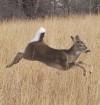Deer population reeling from disease outbreak-JOURNALSTAR.COM; by Art Hovey
"I think throughout the Midwest, there are states dealing with it," said Scott Taylor, wildlife division manager with Game and Parks. "But I think Nebraska is dealing with it to a greater degree than any other state, because the drought conditions are worse than any other state.
"Last year was maybe 10 or less," Taylor said of reports from the public on an often fatal malady inflicted on deer by biting insects. "Within the last 10 years, the highest we've seen is maybe a few hundred."If the drought persists in 2013, the carcass count could rise rapidly again through the summer months.
What happened this year, what could happen next year, and what adjustments might be in order for hunting licenses are prominent topics in a series of big-game meetings across the state this month.
"We've had these deer meetings before," Trindle said, "and they generally draw a crowd of about 25 people. And I think we had a little over 100 last Thursday -- which, to me, is amazing."
Drought contributes in two ways, Taylor said. "The receding water, the standing water leaves a sort of mud line. That mud line provides a habitat for the midge, the biting midge that causes the disease."
Also, as water sources dry up entirely, more deer congregate around the remaining drinking spots, "and there's sort of a recipe for a large outbreak."Along with causing hemorrhaging, the disease makes affected animals feverish. That's why they plunge into water to cool off and why their carcasses often are found in rivers and streams.
Damage to the deer population, mostly whitetails, ended abruptly in October with the freezing temperatures that killed the midges. But in a two-week period in September, the report total reached 1,841.
"This year, because it was unusually hot and dry early, it seemed to start up in July," Trindle said. "And that's another reason this one was so bad." The flare-up won't be viewed as bad news entirely by farmers angry over crop depredation, motorists who've hit deer and others who think the deer population is out of control.
The deer casualty count "comes on the heels of a couple of very liberal hunting seasons," Trindle said. "It's a situation where the level, the remaining level of deer or the population now is probably closer to what we were trying to reach."
Trindle said the most carcasses turned up in a northern tier of counties and in the state's northeast corner.But veteran Kearney bow hunter Rich Walters said he noticed "a significant reduction in deer numbers" in his part of the state."I've been finding a fair number of dead ones along the riverbanks," he said.Walters, 38, called it "the worst outbreak I've ever seen or heard about."
Bow hunting season began in mid-September. He's still trying to bag his second buck as the end of the season approaches this month."It definitely affects the number of deer that you see as a hunter," he said, "but there's nothing we can do about diseases. Hopefully, we can just be proactive and manage them in the future."
"Last year was maybe 10 or less," Taylor said of reports from the public on an often fatal malady inflicted on deer by biting insects. "Within the last 10 years, the highest we've seen is maybe a few hundred."If the drought persists in 2013, the carcass count could rise rapidly again through the summer months.
What happened this year, what could happen next year, and what adjustments might be in order for hunting licenses are prominent topics in a series of big-game meetings across the state this month.
"We've had these deer meetings before," Trindle said, "and they generally draw a crowd of about 25 people. And I think we had a little over 100 last Thursday -- which, to me, is amazing."
Drought contributes in two ways, Taylor said. "The receding water, the standing water leaves a sort of mud line. That mud line provides a habitat for the midge, the biting midge that causes the disease."
Also, as water sources dry up entirely, more deer congregate around the remaining drinking spots, "and there's sort of a recipe for a large outbreak."Along with causing hemorrhaging, the disease makes affected animals feverish. That's why they plunge into water to cool off and why their carcasses often are found in rivers and streams.
Damage to the deer population, mostly whitetails, ended abruptly in October with the freezing temperatures that killed the midges. But in a two-week period in September, the report total reached 1,841.
"This year, because it was unusually hot and dry early, it seemed to start up in July," Trindle said. "And that's another reason this one was so bad." The flare-up won't be viewed as bad news entirely by farmers angry over crop depredation, motorists who've hit deer and others who think the deer population is out of control.
The deer casualty count "comes on the heels of a couple of very liberal hunting seasons," Trindle said. "It's a situation where the level, the remaining level of deer or the population now is probably closer to what we were trying to reach."
Trindle said the most carcasses turned up in a northern tier of counties and in the state's northeast corner.But veteran Kearney bow hunter Rich Walters said he noticed "a significant reduction in deer numbers" in his part of the state."I've been finding a fair number of dead ones along the riverbanks," he said.Walters, 38, called it "the worst outbreak I've ever seen or heard about."
Bow hunting season began in mid-September. He's still trying to bag his second buck as the end of the season approaches this month."It definitely affects the number of deer that you see as a hunter," he said, "but there's nothing we can do about diseases. Hopefully, we can just be proactive and manage them in the future."












No comments:
Post a Comment